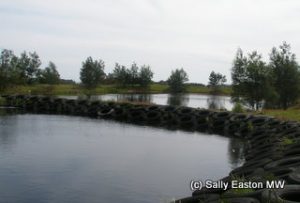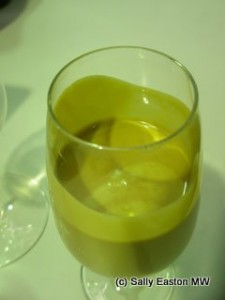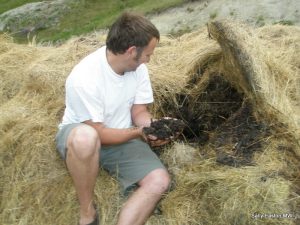Winery waste to winery profit
A version of this article was first published in the January 2016 issue of The Drinks Business.
As part of the sustainability drive, winery waste is increasingly under the microscope. It may traditionally have gone to quite a substantial landfill, but the stuff is chock-full of useful, and profitable, bits and pieces. To the extent that the terminology has been changing to speak of winery by-products, not waste.
What exactly are we talking about? The New Zealand industry for one estimates it takes three litres of water in the winery, i.e. no irrigation water, to make a litre of wine. The OIV estimated global production in 2015 at 275 mhl, so that would be a sizeably large lake of waste water.
Solid waste is essentially grape marc (pomace) – seeds, skins and stems. It’s been estimated that around 13 million tonnes of grape marc is produced globally each year. Marc is rich is many useful things including polyphenols, fibres, tannins, tartaric acid, anthocyanins, sugars, oils… resveratrol for example has been much talked about for a long time.
Liquid waste to liquid assets
Winery waste is usually acidic with a high concentration of organic matter, such as lipids, polyphenols, sugars and tannins. Untreated it can pollute soil, streams and ground water, endangering plant and animal species. Increasingly common treatment prior to re-use is via wetland systems and pools.
For much of the viticultural world, water is precious; it is simply essential to re-use it. For example, Daniel Schietekat, the IPW manager said “South Africa is a very dry country and IPW considers all water (including waste water) as a scare resource. More than 95% of wineries currently dispose of their treated waste water by means of irrigating their wastewater onto land through sprinkler systems” once it has been treated to quality specifications. In significant parts of the old world, irrigation is forbidden. Yet Champagne, for example, which was early into the sustainability fray with a region-wide sustainability programme, re-uses its water. A CIVC spokesperson said “since 2014, 100% of the region’s wastewater is collected, treated or processed for recycling.”
Winery lees are a bit sludgier. Central Otago’s Amisfield winemaker Stephanie Lambert said “we have to dispose of lees, and not to the waterways. We put them on the sheep paddock – they quite like it. We have a wetland. All wastewater and light lees goes to storage tank then to the top of the wetland.” Amisfield developed New Zealand’s first winery waste water recycling plant. Lambert said “It’s a major feather in our cap. All our water is treated on site. There are five cells – the first one is with reeds, natives. Over 30 days it filters to crystal clear water. Then it’s used to irrigate the shelter belt.” But, she added “it takes a lot of management, especially in our dry environment.”
In the USA, Fetzer sells its lees to a third company. Josh Prigge, their director of regenerative development, said “in 2014 we were able to divert and sell about 149,000 gallons of lees. This helps us generate revenue for the lees, and it also saves us water from having to rinse the lees through our waste water treatment, and saves us energy that is used to treat that waste water.” With a month of 2015 left, the company was on target again to divert about 99% of all their waste … which happened to save them around US$700,000. Prigge added Fetzer’s next goal “is to become ‘net positive’ by 2030, [which] means we will have eliminated or offset all negative impacts and only produce positive impacts, resulting in a positive corporate footprint.”
Solid waste to solid gains
Common uses of grape marc that avoid costly landfill include fermentation to produce grape spirit, composting for re-use in the vineyard and use as animal feed. Additionally tartaric acid and grape tannins can be recovered, both of which can be used again in wine production.
Yealands is notably big into composting. Peter Yealands said they “use what would otherwise be landfill waste from other industries to produce 50,000 tonnes of compost a year. It contains bark, mussel shells, seaweed, lime as well as grape marc from Yealands Estate and other Marlborough wineries.”
For solid waste as well as lees, Schietekat said “we encourage wineries to take usable solid waste to a company such as Brenn-o-Chem. who specialize in transforming winery waste.” Brenn-o-Kem’s commercial director Kobus du Toit said “we buy wine lees and take it to our Worcester plant where we have a centrifuge system to recover wine, yeast and tartrates. The wine is sold to larger wine companies for use in the production of brandy and fortified wines. The yeast is composted and used for animal feed. The calcium tartrate is sent to plants in Spain and Italy for the production of tartaric acid. The South African wine industry is too small to justify a viable tartaric acid plant, and exporting to the northern hemisphere helps to keep the plants there occupied in their off season. We then bring back the tartaric acid, about 90% of which goes to the wine industry and 10% we sell to the pharmaceutical industry for the production of mainly effervescent products.”
In Champagne, marc generated by the pressing centres are “delivered to distilleries and treated in order to obtain compounds such as ethanol, grapeseed oil, polyphenols and fertilisers.” For example the Goyard distillery in Ay has 430 collection points in Champagne, collecting both marc and lees for this purpose.
Research at the AWRI looks promising in different directions. A common first option for marc is ethanol production. Tests have found that recovery rates using enzyme and acid pre-treatments on marc suggest alcohol yield from pre-treated marc could be increased by nearly 50%. This has potential implications for use as biofuel. Elsewhere, cows and sheep are being targeted. In Australia ruminants are responsible for nearly 10% of the country’s total greenhouse gas emissions. Feed containing tannins can reduce their methane production. Research has found grape marc tannins in animal feed could reduce methane production by up to 20%.
Seeds of recovery
Grape seeds are increasingly valuable. Seeds can provide grapeseed oil, grapeseed extracts and grapeseed flour. Supplements have been sold for over a decade. They have uses in the food, nutraceutical, cosmetics and pharmaceuticals industries.
Health is high on the agenda for products of grape marc. The anti-oxidant, anti-carcinogenic, anti-inflammatory, anti-bacterial properties of polyphenols (including resveratrol, anthocyanins, quercetin, catechin, phenolic acids etc) are widely documented elsewhere, and wine grapes are one of the most abundantly grown fruit crops, so the industry is rightly a high profile target for development.
Research by Dr. Wally Yokoyama at the US department of agriculture is suggesting “grape seed flours may prevent or improve the physiologic characteristics associated with obesity-related metabolic diseases. We know that obesity and metabolic diseases are associated with inflammation that originate from gut bacteria.” He went on “grape seed flour contains a small amount of polyphenols and a large amount of fibre. They both act as prebiotics in different ways. Grape seed flour dramatically changes the number of gut bacteria and certain species of gut bacteria” in a way that results in lower cholesterol, less liver fat, lower weight gain and lower body weight. In developed countries where the intake of antioxidants and fibre is typically low, the health benefits seem evident.
Yokoyama also said “grape seed has one of the highest contents of anti-inflammatory polyphenols. The type of polyphenols is similar to those found in chocolate, tea and cinnamon … because so many diseases are related to inflammation, Alzheimer’s, fatty liver disease, obesity, and diabetes are on the potential [health benefit] list. The areas of research are almost unlimited.”
By comparison, he added “cereal grains contain phenolic acids. Phenolic acids also have nutritional benefits but are absorbed by the intestine and probably do not have as great an effect on gut bacteria, the source of inflammation and metabolic diseases.”
With so many uses for winery by products, there is clear incentive to maximise recovery. Potentially exciting work being done in Italy on the invention of a multi-purpose refinery suggests several products could be recovered from marc. Research fellow Gonzalo Martinez of the University of Bologna said his and his colleagues’ work suggests “a sequence of recovery, first polyphenols, then we produce bioplastics, and with the waste from these two we produce biogas rich in methane.” The bioplastics can be used to make such things as plastic bags, bottles and food packaging.
He further explained that both polyphenols and tartaric acid can be produced from the same batch because these two products are “not competing. But it’s not the case with polymers. Once you separate the polyphenols, you can then either get tartaric acid or you can ferment again, anaerobically and under acidogenic conditions, to produce short chain organic acids. These are then used to produce biopolymers.” Also, the polyphenols were extracted by supercritical carbon dioxide (a technique used in the production of Diam stoppers). This method extracted 2.7g of total polyphenols from 100g of dry marc, which is about the same extraction rate as other methods, but the antioxidant activity was ten times greater using supercritical carbon dioxide.
At the end of the entire recovery process Martinez added “the exhausted stream could then be used as a fertiliser.” His next stage is to scale it up.
To its credit, the wine industry is gearing proactively to sustainability issues. In New Zealand winery by-products are one of SWNZ’s seven pillars of sustainability. Chile’s sustainability code places water under one pillar, and waste and residue management under another. The specific targeting of winery waste is fairly new to the sustainability code, which itself is only five years old. Patricio Parra, the head of sustainability programme for Chile, said “there are projects of cosmetics (creams and exfoliating soaps), food ingredients and grapeseed oil” as well as tartaric acid recovery and composting. For example, what pomace and stems are not used internally by Concha y Toro are sold to a third party for recycling. Lees are also sold on.
A whole chapter on solid waste management exists in the California code of sustainable winegrowing with a separate chapter dealing with water, both use and re-use. Allison Jordan, the executive director of the California Sustainable Winegrowing Alliance said “by reusing winemaking by-products – including stems, skins, seeds, and lees – wineries can help divert waste from the landfill, re-use nutrients in a way that is beneficial for other purposes, and potentially create something of value that can further enhance their economic sustainability.” She explained pomace was mainly re-used in vineyards as compost and added “in a few cases, grape seeds are extracted and converted to high-value products such grape seed oil and nutritional supplements.” Jackson Family Wines are one such, with their sister company, Whole Vine, making oils and flours.
Bringing it back to practical options for the winery … the quick and easy wins, said Prigge are “diverting lees and composting grape waste [which] help you save money on energy, water, and landfill costs.” But could it be profitable and sustainable to separate grape seeds onto a different path?






